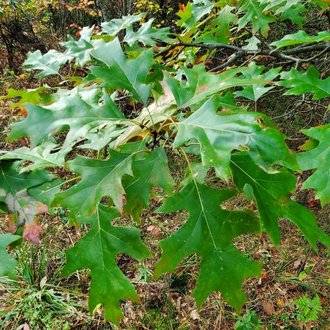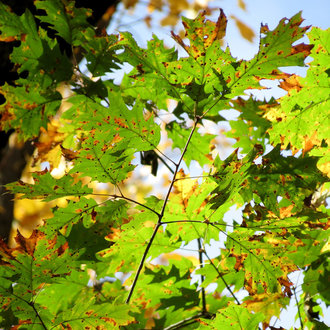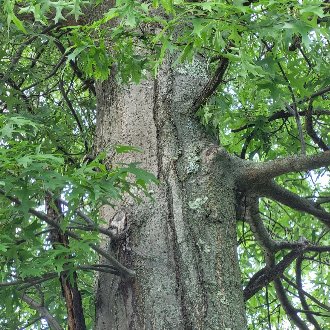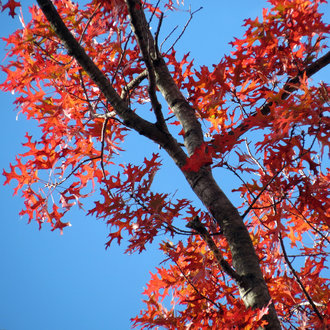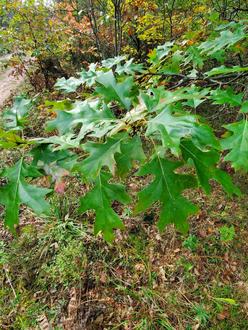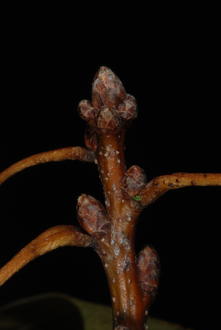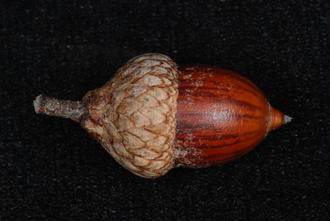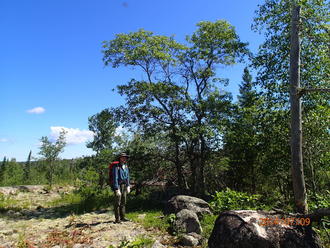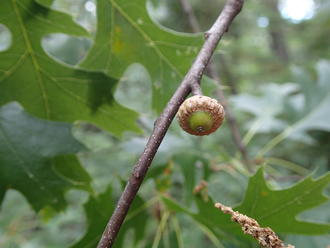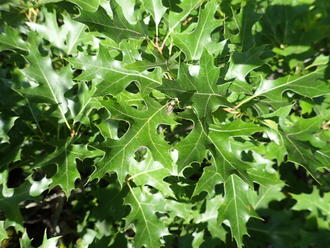Hill's Oak (Quercus ellipsoidalis E.J. Hill)
Also known as northern pin oak, jack oak, upland pin oak.
↑Summary
A cold-hardy, drought-tolerant oak mostly found in a small region of the upper midwestern U.S. Also called Northern Pin Oak, but more closely related to other species than pin oak.
↑Description & Identification
A medium-sized deciduous tree to 70 feet (21 m) in height. Crown is irregular and often open and thin. Often retains stubs of lower dead branches. Leaves have 5-7 lobes; mature trees have deep sinuses between lobes, extending more than halfway to the leaf's midrib.
Root system is extensive, consisting both of a deep taproot and widespreading and deep lateral roots.
↑Similar Plants
↑Habitat
Limited to dry, upland sites with acidic, sandy soils and little organic matter. Within its range, it is the most drought-tolerant of all oaks of the red oak group. Common on sand plains of glacial origin, and also on sandstone hills.
On sites capable of supporting more shade-tolerant vegetation, functions as a pioneer species and is replaced by other oaks including white, black, northern red, and bur oaks, as well as by eastern white pine. However, persists indefinitely on nutrient poor, dry sites where other hardwoods cannot survive.
Common in habitats that burn regularly. Often forms a stable community together with jack pine (Pinus banksiana) on sites with too regular and/or too severe fires for other tree species to survive.
↑Life Cycle
Seedlings quickly establish a deep taproot.
Trees begin producing seed around 20 years of age; acorns take two seasons to mature. Good seed crops are produced every 2-3 years; in other years, most of the seed is destroyed by weevils. Seeds are distributed mostly by squirrels and blue jays, and by gravity on hillier sites.
Seed requires a period of cold dormancy, and germinates in the spring. We could not find any record of seed banking and seed of this species probably does not survive more than one year.
Mature trees are usually unaffected by low-intensity fires, but young trees with small diameter stems can be killed by fire, and severe fires can kill mature trees. However, trees that are top-killed resprout vigorously.
↑Related Plants
This species is most closely related to scarlet oak (Quercus coccinea), which has a more southerly and easterly distribution and only overlaps with it in range in a small region from southeast Wisconsin around the south shore of Lake Michigan.
It is also related to northern red oak (Quercus rubra) and black oak (Quercus velutina); both of these species overlap more with this one in range, and can form hybrids.
↑Notes
We use the name "Hill's oak" over the commonly used name "northern pin oak" because that name is misleading. This species is not as closely related to pin oak (Quercus palustris) and has radically different ecology and habitat preferences. Although "Hill" is a name, it is a convenient reminder that this species prefers upland habitats. The common name "Jack oak" is also perhaps more illustrative because this species frequently co-occurs with jack pine, but it can be confused with the hybrid Jack's oak (hybrid) (Quercus ×jackiana) which is not closely related, belonging to the white oak group.
↑Links & External Resources
• Northern Pin Oak | Fire Effects Information System (FEIS) (About This Site)
• Quercus ellipsoidalis (Jack Oak) | USDA PLANTS Database (About This Site)
• Northern Pin Oak | iNaturalist (About This Site)
• Quercus ellipsoidalis (Northern Pin Oak) | Missouri Botanical Garden Plant Finder (About This Site)
• Northern Pin Oak | Virginia Tech Dendrology Factsheets (About This Site)
• Quercus ellipsoidalis | Biota of North America Project (BONAP) (About This Site)
• Quercus ellipsoidalis | NatureServe Explorer (About This Site)
• Quercus ellipsoidalis | Flora of North America (About This Site)



